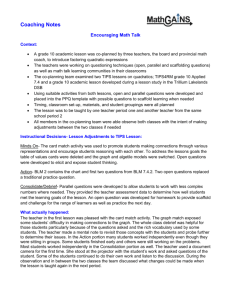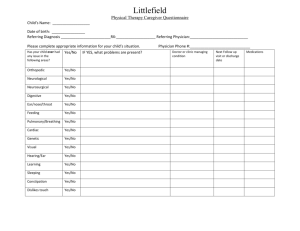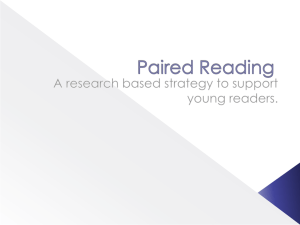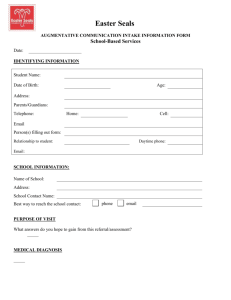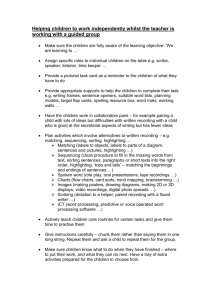RAD Scope Sequence Grades 1-4
advertisement
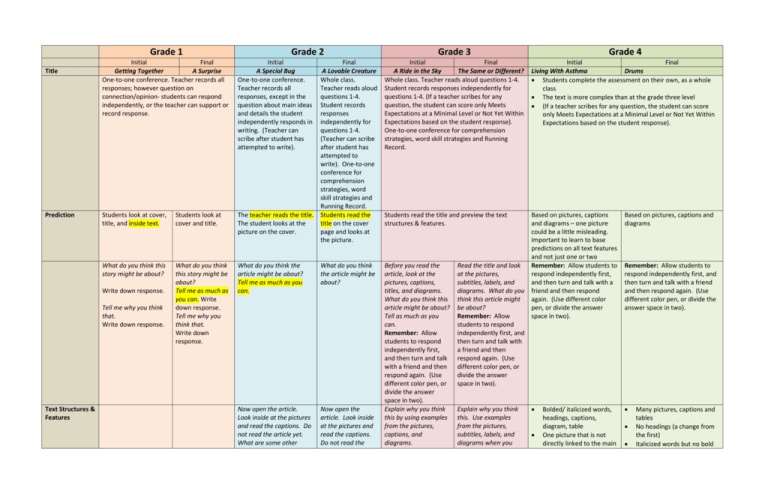
Grade 1 Title Prediction Initial Final Getting Together A Surprise One-to-one conference. Teacher records all responses; however question on connection/opinion- students can respond independently, or the teacher can support or record response. Students look at cover, title, and inside text. Students look at cover and title. What do you think this story might be about? What do you think this story might be about? Tell me as much as you can. Write down response. Tell me why you think that. Write down response. Write down response. Tell me why you think that. Write down response. Text Structures & Features Grade 2 Initial A Special Bug One-to-one conference. Teacher records all responses, except in the question about main ideas and details the student independently responds in writing. (Teacher can scribe after student has attempted to write). Grade 3 Grade 4 Final A Lovable Creature Whole class. Teacher reads aloud questions 1-4. Student records responses independently for questions 1-4. (Teacher can scribe after student has attempted to write). One-to-one conference for comprehension strategies, word skill strategies and Running Record. The teacher reads the title. Students read the The student looks at the title on the cover picture on the cover. page and looks at the picture. Initial Final A Ride in the Sky The Same or Different? Whole class. Teacher reads aloud questions 1-4. Student records responses independently for questions 1-4. (If a teacher scribes for any question, the student can score only Meets Expectations at a Minimal Level or Not Yet Within Expectations based on the student response). One-to-one conference for comprehension strategies, word skill strategies and Running Record. Initial Final Living With Asthma Drums Students complete the assessment on their own, as a whole class The text is more complex than at the grade three level (If a teacher scribes for any question, the student can score only Meets Expectations at a Minimal Level or Not Yet Within Expectations based on the student response). Students read the title and preview the text structures & features. Based on pictures, captions and diagrams What do you think the article might be about? Tell me as much as you can. What do you think the article might be about? Remember: Allow students to respond independently first, and then turn and talk with a friend and then respond again. (Use different color pen, or divide the answer space in two). Now open the article. Look inside at the pictures and read the captions. Do not read the article yet. What are some other Now open the article. Look inside at the pictures and read the captions. Do not read the Before you read the article, look at the pictures, captions, titles, and diagrams. What do you think this article might be about? Tell as much as you can. Remember: Allow students to respond independently first, and then turn and talk with a friend and then respond again. (Use different color pen, or divide the answer space in two). Explain why you think this by using examples from the pictures, captions, and diagrams. Based on pictures, captions and diagrams – one picture could be a little misleading. Important to learn to base predictions on all text features and not just one or two Read the title and look Remember: Allow students to at the pictures, respond independently first, subtitles, labels, and and then turn and talk with a diagrams. What do you friend and then respond think this article might again. (Use different color be about? pen, or divide the answer Remember: Allow space in two). students to respond independently first, and then turn and talk with a friend and then respond again. (Use different color pen, or divide the answer space in two). Explain why you think this. Use examples from the pictures, subtitles, labels, and diagrams when you Bolded/ italicized words, headings, captions, diagram, table One picture that is not directly linked to the main Many pictures, captions and tables No headings (a change from the first) Italicized words but no bold things the article might be about? Tell me as much as you can. – Teacher records answers. Picture & Diagram Running Record explain your thinking. Pictures, captions, diagrams Pictures, subtitles, labels, diagrams This story is about two children, Kiran and Paul, who get a surprise. Now, I would like you to read the story to me. Good readers…what strategy or strategies did you use to read the word? How did this help you? **Completed at the end of the assessment. This section is a one-to-one conference after the student has read and answered the questions in the response booklet. Order of questions is 1) Comprehension strategies; 2)Word skills; 3) Running Record. **Completed at the end of the assessment. This section is a one-to-one conference after the student has read and answered the questions in the response booklet. Order of questions is 1) Comprehension strategies; 2)Word skills; 3) Running Record. Good readers…what strategy or strategies did you use to read the word? How did this help you? – Teacher records answer Good readers…what strategy or strategies did you use to read the word? How did this help you? – Teacher records answer Comprehension Strategies Good readers….point to a place and tell me what you did to understand that part of the story. What strategy or strategies di you use? How did this help you? Good readers….point to a place and tell me what you did to understand that part of the story. What strategy or strategies di you use? How did this help you? – Teacher records answer Good readers….point to a place and tell me what you did to understand that part of the story. What strategy or strategies di you use? How did this help you? – Teacher records answer Retell/Main Ideas/Details Tell me some things the children did together in the story. Tell me as much as you can. Students independently read the article and respond independently to question #2 on Main Ideas & Details What do they look like? | What do they do? (Teacher can scribe after the student has attempted to write independently). Comprehension is scored as a whole (student and teacher scribed information). Students independently read the article and respond independently to question #2 on Main Ideas & Details Chart: How hot-air balloons work…first, next…last. Word Skills This story is about children who get together to do different things. Now I would like you to read the story to me. article yet. What are some things the article might be about? Explain why you think this. – Students turn and talk. Students independently write down responses. Pictures Tell me important things that happen in the beginning, middle, and end of the story. Students independently read the article and respond independently to question #2 on Main Ideas & Details What did you learn about sea otters and their fur? What did you learn about sea otters and the food they eat? What did you learn about sea otters and their babies? (Teacher can scribe after the student has attempted to write independently). Students independently read the article and respond independently to question #2 on Main Ideas & Details Chart: How dolphins and porpoises are the same and how they are different. idea – non-literal correlation should be practiced as part of main idea practice “Puffer” – why quotations marks? What do they mean? The prompt is detailed in this assessment – guides the students to answer fully No running record (like the first one) The prompt is less detailed in this assessment – there is an assumption that students now understand how text structures and features support predictions No running record Students are given a choice of skills to choose from after reflecting on their reading. They need to be able to identify when they come in contact with a word they aren’t sure of immediately. This will need to be practiced Students are given a choice of strategies to choose from after reflecting on their reading. Students need to become aware of when they use a strategy. They will need to practice with challenging texts (this may vary from student-to-student). They have to be able to discuss how this strategy helps them make sense of the text. The term big idea is used The term big idea is used instead of main idea. instead of main idea. Main idea and details are Main idea and details are assessed separately. assessed separately. The students need to use The students need to use the the square graphic round graphic provided provided Quality of supporting details is important, as is expressing their thoughts accurately and completely Accuracy/ Completeness Inferences How do you think the children feel in this story? Tell me why you think that. How do you think Kiran and Paul felt about the surprise? Tell me why you think that. Connections/ Opinions This story makes me think of… I like/do not like this story because… (students can respond independently or the teacher can support and record answer) Scored on student’s independent work. Comprehension is scored as a whole (student and teacher scribed information). Scored on student’s independent work. Teacher reads question #3 on inferences and records student’s response. Why do you think mother ladybugs lay their eggs near where aphids live? Teacher has read question #3 to students before reading. Student reads questions and responds to question independently. Why do sea otters hunt for their food underwater? Teacher reads question #4 on Connections/Opinions and records student’s response. In the article the author says that ladybugs have different names. What name do you like better: ladybug, lady beetle, or lady bird? Tell me why you think that. Teacher has read question #4 to students before reading. Student reads question and responds to the question independently. What do you think a mother sea otter and its baby would do in a big storm? Teacher has read question #3 to students before reading. Student reads questions and responds to question independently. What do you think would happen to the basket and the balloon if the air was not heated? Explain as much as you can. Teacher has read question #4 to students before reading. Student reads question and responds to the question independently. Do you think a hot-air balloon is the best way to fly from one city to another? Explain as much as you can. Teacher has read question #3 to students before reading. Student reads questions and responds to question independently. What needs to be done to keep dolphins or porpoises safe in our oceans? Teacher has read question #4 to students before reading. Student reads question and responds to the question independently. Describe the perfect habitat for a dolphin or porpoise, and tell why it’s perfect. Students need to be able to fully express their ideas, using the graphic organizer provided. This category isn’t so much about the actual ideas (that is assessed in main idea and details), but about filling in the graphic, using complete thoughts and taking time to write about reading. Understanding of the prompt is necessary. Students need to understand Students need to understand the what causes swelling and have ways drums can communicate a had experiences with having a message and have had friend visit. Looking at the experiences with ceremonies and table will be important. other musical events. Looking at Students should practice using the last part of the article will be all information given to make important. Students should inferences and combining this practice using all information information with their own given to make inferences and experiences. combining this information with their own experiences. A single prompt and response will be used to assess two criteria. Students will need to become familiar with really fleshing out ideas, expressing opinions and supporting thoughts with details. Having students practice with sentence starters like ‘I think…” and “I feel…” because… will really help them get used to formulating opinions Add to the question in the initial assessment: Tell why.




